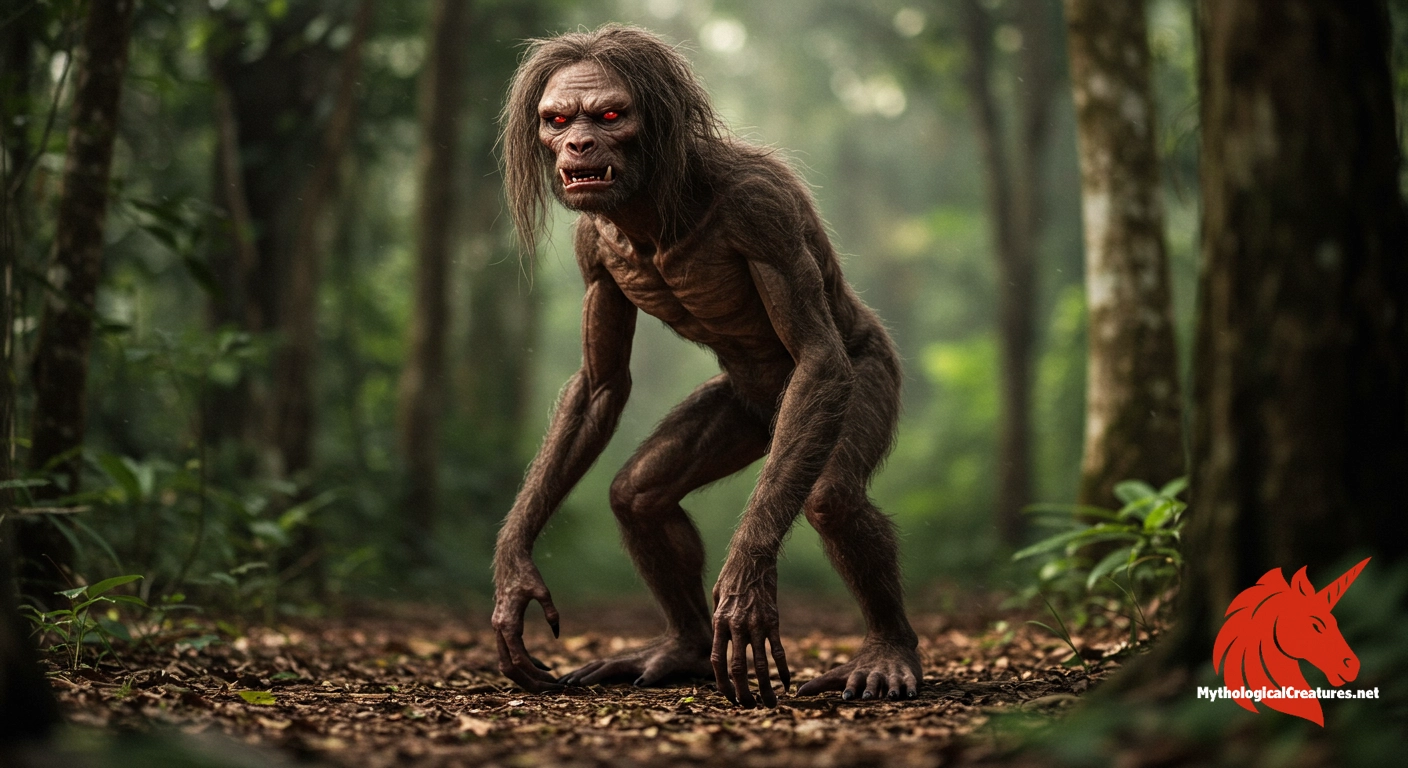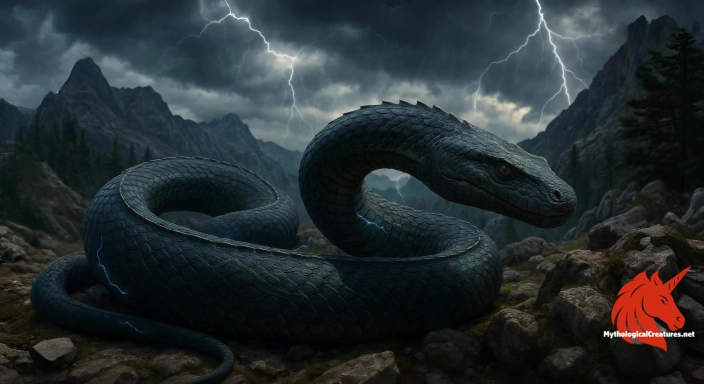Kalanoro: The Kalanoro is a small, hairy humanoid cryptid from Madagascar, believed to now exist as a spirit after its corporeal form vanished.

Kalanoro
Kalanoro - Embodies the interplay between nature, loss, and the spirit world while serving as a cautionary yet enigmatic figure in Malagasy culture
Origins & First Encounters
The Kalanoro are enigmatic cryptid beings that have long captured the imagination of Madagascar’s inhabitants. Their mythic origins are intertwined with the island’s ancient rainforests, where they once roamed in corporeal forms until environmental changes rendered them spiritual. Their elusive presence has been commemorated through a tapestry of local narratives that blend wonder with caution. Early cultural narratives hint at their dual nature, portraying them as both guardians and mischief-makers. The evolution from tangible forest dwellers to intangible spirits underscores the dynamic relationship between nature’s cycles and human experience. Myths concerning the Kalanoro have been an integral part of community life, serving to explain the unpredictable forces of the natural world. The lore of these mysterious entities is deeply embedded in the cultural heritage of the region, resonating with themes of survival, loss, and transformation. Over time, their story has grown richer, symbolising not only the fragility of nature but also the enduring power of myth to adapt to new realities. This enduring narrative continues to inspire reflection on the intricate interplay between human civilisation and the wilderness.
Source Texts & Tale Variants
The earliest narratives concerning the Kalanoro originate from rich oral traditions that have been passed down through generations on Madagascar. Varied accounts recorded in local storytellings illustrate a creature whose character is as multifaceted as the island’s cultural landscape. Some accounts presented by indigenous communities reveal the Kalanoro as secretive beings whose actions often mirror the moral dilemmas of human society. Local manuscripts and folk tales have preserved multiple story variants that range from benign protectors to omens of misfortune. In certain communities, accounts speak of the Kalanoro intervening when children are deemed at risk, while in others, they embody a spirit that exacts retribution for social transgressions. Modern encounters, noted by documentary investigations such as the episode on Destination Truth, have added contemporary layers to these traditional tales. The collection of narratives across different regions underscores the fluidity of myth, with each version offering distinct insights into the creature’s character. The diversity of these sources highlights how both ancient and recent testimonies contribute to an evolving mythos that continues to captivate and perplex.
Form & Powers
The physical depiction of the Kalanoro is one of its most arresting aspects, presenting a figure that is both familiar and unearthly. They are generally described as small, hairy humanoids whose appearance is marked by distinctive fangs that lend an intimidating aspect to their visage. Unconventional anatomical features, such as legs with a reverse orientation and backwards facing feet, set them apart from commonplace human characteristics. Glowing red eyes add an eerie luminescence to their portrayal, often evoking a visceral reaction of both awe and unease in observers. Their long, untamed hair and unkempt fingernails further enhance their wild, almost feral presence. Despite their diminutive size, their physical features suggest an agility and mystique that defies simple interpretation. Variations in descriptions abound, with some accounts hinting at an almost spectral translucency or subtle animalistic traits that blur the boundaries between human and beast. Each element of their appearance is rich in symbolic meaning, conveying the inherent link between the natural world’s beauty and its latent dangers. The composite vision of the Kalanoro remains a striking example of how physical form in myth can encapsulate the extraordinary and the uncanny.
Regional Faces
The depiction of the Kalanoro shifts subtly across different regions of Madagascar, reflecting the local customs and environmental nuances of each community. In coastal areas, the creature is sometimes envisioned as a benevolent spirit whose mysterious interventions signal impending change. Inland, tales are often more cautionary, emphasising traits of mischief or even malevolence linked to the Kalanoro. Among the Sakalava, narratives have been crafted that portray these beings as having a dual nature, capable of both kidnapping and later returning children based on the perceived treatment they receive. Remote mountainous villages tend to describe them with heightened ferocity and animal-like qualities, aligning closely with the untamed aspects of the wilderness. Variance in physical descriptions and behavioural attributes underscore a deep interrelationship between local belief systems and the natural environs. These narratives, which adapt to the cultural and ecological context of each region, underscore a collective memory that is both diverse and enduring. Moreover, local adaptations of the myth serve as reflections of communal challenges, reinforcing the role of the Kalanoro as symbols of nature’s unpredictable forces. Across the island, such variations ensure that the myth remains a living, mutable element of Madagascar’s cultural identity.
Cultural Parallels
The Kalanoro resonate with figures from a myriad of global mythologies, drawing intriguing comparisons with creatures known for their blend of benevolence and mischief. Comparable entities in European folklore, such as the fae, share a similarly ambiguous relationship with humanity that oscillates between nurturing and trickster roles. In many indigenous narratives, spirits that protect or punish reflect a universal motif of nature’s duality, echoed in the Kalanoro’s portrayal. Their enigmatic qualities bear a resemblance to the elusive sprites and forest spirits found in various cultures, suggesting a common human impulse to personify the mysteries of the wild. This comparative landscape reveals that the tension between fear and adoration is a recurring theme across disparate traditions. The Kalanoro’s dual reputation mirrors that of other mythic beings who exist on the threshold of the known and the unknown, challenging the binary of good versus evil. Such cross-cultural parallels underscore a shared human endeavour to symbolise the gaps in our understanding of nature. As the craft of myth-making transcends geographical divides, the narrative of the Kalanoro stands as a testament to the universal language of mystery and transformation. Their enduring presence within comparative mythologies reaffirms the idea that archetypal figures often serve as bridges between the material world and the ineffable realms beyond.
Legacy & Modern Evolution
The historical evolution of the Kalanoro reflects a dynamic interplay between ancient environmental narratives and modern cultural reinterpretations. Their transition from tangible, rainforest-dwelling entities to elusive spectral figures mirrors broader changes in the island’s ecological and social landscapes. Over the centuries, their myth has absorbed contemporary concerns, notably symbolising themes of loss, resilience, and the impact of habitat destruction. Modern portrayals often integrate these beings into discussions about environmental degradation and the responsibility of preserving natural heritage. Television documentaries and cultural media have reinvigorated interest in the Kalanoro, blending the allure of myth with the investigative spirit of modern exploration. As communities embrace new ways of storytelling, the Kalanoro are recast as both cautionary figures and enigmatic guardians of forgotten traditions. Their multifaceted legacy is steeped in allegory, inviting reflection on the intersection between the supernatural and the urgent issues of conservation. The continuous reinvention of their narrative mirrors the adaptive nature of myth itself, ensuring that the Kalanoro remain a potent symbol in contemporary environmental and cultural discourse. This modern legacy underscores the timeless appeal of myths, offering both a bridge to the past and insights into current ecological challenges.
Interesting Fact
The Kalanoro is sometimes associated with modern social issues such as alcoholism, reflecting how folklore adapts to contemporary societal challenges.
Quick Creature Info
Origin:
Features:
Our Mythic Legendary Rating:

Habitat:
Supernatural Powers:
Physical Attributes:
Abilities:
Behavior:
Weaknesses:
Lore:
Related Creatures, Tales or Lore
- TTikoloshe
- PPukwudgie
- CChaneque
References
Discover Another Mythical Legend You May Not Have Heard Of?
Uncover the mysteries of ancient folklore and expand your knowledge of legendary beings from cultures around the world.
Dare to Meet the Sugaar....
Curated by the Mythological Creatures Team (rev. May 2025)
